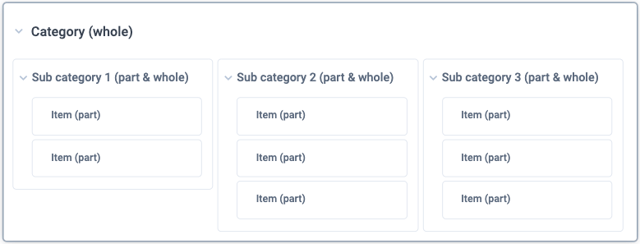Jig: Categories
 Derek & Laura Cabrera
·
3 minute read
Derek & Laura Cabrera
·
3 minute read
Excerpt from the book: Systems Thinking Made Simple, Chapter 5
This blog is part of a set of blogs under the"cognitive jigs."Be sure to check out the tag to read them as a group and learn how cognitive jigs are at play in our everyday lives.
Analogies, similes, and metaphors are powerful cognitive jigs in large part because they help us to relate unfamiliar things with familiar things. But there's another cognitive jig that you are already familiar with: categories. Categories have a similarly long history to analogies, but categories have become insidious.
We could say similarly nice things about the marvelous "invention" of the category as we did about analogies. The invention of the category dates back to Aristotle (B.C. 384–322). Today we can hardly imagine what it would be like to exist in a world unstructured by categorization. Like analogies, categories have much to be admired. It is common parlance in the field of cognitive science to say that categories are universal cognitive structures—that we cannot survive nor have a thought without them. Yet categories have a dark side: they are a cognitive cul de sac or dead end in the road. Categorization makes us feel like we are getting somewhere, speeding down the highway of understanding and knowledge until Wham!, dead end. We’re stuck. And, it usually takes a long time to get unstuck.
“Are you serious?” That’s usually the reaction we get when we say that we are suspicious of categories. After all, categorization has given us so many gifts of understanding:
Categories have a dark side: they are a cognitive cul de sac or dead end in the road. Categorization makes us feel like we are getting some- where, speeding down the highway of under- standing and knowledge until Wham!, dead end. We’re stuck. And, it usually takes a long time to get unstuck.
- The scientific disciplines (e.g., physics, chemistry, biology, psychology, sociology, economics);
- The hierarchy of biological classifications (Life, Domain, Kingdom, Phylum, Class, Order, Family, Genus, Species);
- Bloom’s Taxonomy (Knowledge, Comprehension, Application, Analysis, Synthesis, Evaluation); and
- The organization of the Internet, your computer desktop, office filing systems, libraries (directory structure, file folders, Dewey decimal system, etc.)

Figure 5.6: Outdated Categories
Categories make us feel like we understand the universe be- cause we are able to cognitively capture it. The question is, do categorical structures adequately represent the real structure of the universe? Do categories help us feel or be more knowledgeable? Let’s take another look at the above examples.
- The scientific disciplines: the categorization of knowledge into scientific disciplines did a lot to propel scholarship and knowledge accumulation, but today it poses us real problems. This is because the universe we are trying to understand and the problems we are trying to solve do not heed our disciplinary boundaries. The universe and all of the problems in it are interdisciplinary. University policies and financial structures, departmental culture and tenure structure, and our own thinking is hindered by the categories we set up. Our categorization of knowledge into disciplines has turned into a cul de sac that is going to take a long time to escape.
- The hierarchy of biological classifications: we teach it in schools as if it's fact but the “species concept” is wildly complex and nothing like the streamlined categories we all learned in grade school. Today, scientists have not 1 but 21 equally valid and useful perspectives on how to group organ- isms into species, including morphologically, ecologically, genetically, and through mate recognition. Which perspective the scientist uses depends on the job at hand. Bacteria pose significant problems for categorization. What used to be a biological freeway to understanding has become a categorical cul de sac.
- Bloom’s Taxonomy: very few ideas are as popular or influential in education today as Bloom’s. Yet few teachers can put it to practice and research validates none of it. Despite this, it was recently revised, demonstrating our allegiance to categories despite their infidelity to reality. Knowledge and higher-order thinking skills are far too robust and complex to stuff into Bloom’s discrete categorical prison. It’s going to take years to retrain teachers to get out of this cul de sac.
- The initial organization of the Internet, your computer desktop, office filing systems, the Dewey decimal system: filing systems, computer desktops and even the world wide web have been organized using categories dating back to their origins. That’s exactly why no one can find anything. Another categorical cul de sac. Take for example the early organization of the Internet, which directories like Yahoo! organized by categories. Searching seldom led to finding. Google revolutionized our ability to find things through keyword searches and relational networks. Likewise, searching by keyword for files on your computer is far more successful than searching through nested folder systems only to realize that the mind- set you're in at present isn't the same mindset you were in when you saved the file to a particular folder.
Worst among the impacts of blind category use are the categorization skills we teach to children that lead them to be less robust, more black-and-white, and less adaptive thinkers. We say that categories are insidious because it is a fitting description of how they operate: “proceeding in a gradual, subtle way, but with harmful effects."
What DSRP structure reveals is that the application of discrete categories to real-world phenomena is inadequate to fully understand something. Instead, we must see that all categorization is based on a perspective (which is usually not made explicit). If we are to escape the category cul de sac but still benefit from its use we should replace static categories with part-whole systems grouped dynamically by perspectives.





